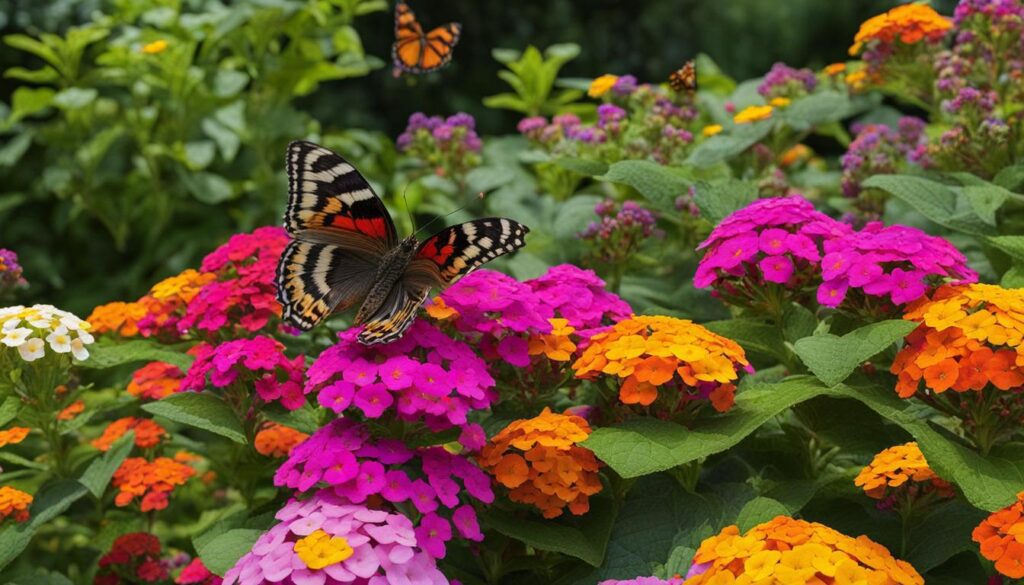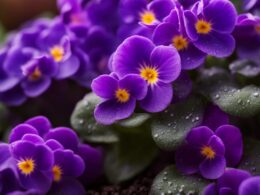Lantana is a beloved garden plant renowned for its vibrant and colorful flowers. But did you know that adding companion plants to your lantana garden can take your gardening success to new heights? By carefully selecting companion plants that complement lantana’s beauty and meet its specific needs, you can create a visually stunning and thriving ecosystem in your garden.
Post Summary
- Choosing companion plants for lantana based on color, texture, size, and bloom time can greatly enhance its visual appeal.
- Varied foliage, such as variegated or burgundy, can provide an attractive contrast to lantana’s unique leaf structure.
- Varying the heights and shapes of companion plants creates visual interest and a balanced look.
- Butterfly-friendly plants like salvia, verbena, and coneflower can attract pollinators to your lantana garden.
- Incorporating both annuals and perennials can ensure a sustainable habitat for butterflies while adding vibrant colors to your garden.
Choosing the Right Colors and Textures
When it comes to companion plants for lantana, choosing the right colors and textures can make a significant impact on the overall aesthetic of your garden. Lantana flowers are known for their vibrant colors, so it’s important to select plants that complement and enhance these hues. Consider incorporating plants with softer, muted colors like white or cream, or opt for cool colors like blue or violet to create a visually appealing contrast.
Additionally, texture plays a crucial role in creating an interesting and dynamic garden design. Combine the coarse texture of lantana with plants that have different leaf textures, such as fine or feathery foliage. This contrast in texture will add depth and dimension to your garden, making it visually engaging and captivating.
Selecting the Perfect Color Palette
To create a harmonious and cohesive look, it’s essential to consider the color palette of your companion plants. Experiment with combinations of complementary or analogous colors for a visually striking effect. Complementary colors are located opposite each other on the color wheel and create a vibrant contrast, while analogous colors are adjacent to each other and provide a more harmonious and subtle blend.
Remember, the goal is to enhance the beauty of the lantana flowers, so choose colors that complement rather than overpower them. By selecting plants with the right colors and textures, you can create a visually stunning garden that will be the envy of your neighborhood.
| Plant | Color | Texture |
|---|---|---|
| Lamb’s Ear (Stachys byzantina) | Muted gray-green | Soft and fuzzy |
| Blue Salvia (Salvia farinacea) | Deep blue | Smooth and glossy |
| Plumbago (Ceratostigma plumbaginoides) | Soft blue | Small, rounded leaves |
| Dusty Miller (Senecio cineraria) | White or silver-gray | Lacy or fern-like |
| Black-Eyed Susan (Rudbeckia hirta) | Golden yellow | Coarse and rough |
Table: Companion Plants for Lantana with Color and Texture
Foliage to Contrast with Lantana’s Leaves
When planning your lantana garden, don’t overlook the importance of foliage in creating a visually appealing contrast. Lantana’s unique leaf structure can be enhanced by choosing companion plants with different foliage colors and textures. Consider plants with variegated foliage, burgundy leaves, silvery-gray foliage, or purple foliage to add depth and visual interest to your garden.
A table showcasing companion plants with contrasting foliage for lantana:
| Companion Plant | Foliage Color | Foliage Texture |
|---|---|---|
| Heuchera (Coral Bells) | Varies (e.g., burgundy, lime green, silver) | Smooth or ruffled |
| Dusty Miller | Silvery-gray | Fuzzy |
| Purple Heart | Purple | Heart-shaped |
| Coleus | Varies (e.g., burgundy, chartreuse, purple) | Varies (e.g., scalloped, serrated) |
By carefully selecting companion plants with contrasting foliage, you can create a harmonious blend that highlights the unique leaf structure of lantana. These combinations will not only add visual appeal to your garden but also create a more dynamic and interesting landscape.
Plant Height and Shape Considerations
When creating a garden bed with lantana, the heights and shapes of companion plants play a crucial role in achieving a balanced and visually appealing look. By carefully considering the heights and shapes of the plants you choose, you can create a dynamic and harmonious garden landscape.
Varying the heights of plants within your garden bed creates visual interest and adds depth to the overall design. Consider selecting tall plants that can serve as a backdrop for lantana’s vibrant flowers. These taller plants can provide a dramatic element to the garden while allowing the lantana to take center stage. Additionally, shorter plants can be used as ground cover or border plants to create a defined edge and add a sense of structure to the garden.
Shapes also play a significant role in garden design. Mixing plants with different growth habits, such as shrubs, grasses, and perennials, can provide an interesting contrast to the lantana’s spreading or upright growth habit. Combining plants with varied shapes creates a visually pleasing composition, enhancing the overall beauty of the garden.
| Plant Name | Height | Shape |
|---|---|---|
| Purple Fountain Grass | 3-4 ft | Upright, arching |
| Sunshine Ligustrum | 4-6 ft | Columnar |
| Black-Eyed Susan | 2-3 ft | Upright |
| Creeping Thyme | 2-4 in | Spreading |
| Blue Fescue | 8-12 in | Mounded |
By carefully considering the heights and shapes of companion plants for lantana, you can achieve a balanced and visually captivating garden bed. The combination of tall and short plants with varied shapes will create an aesthetically pleasing landscape that highlights the beauty of the lantana and adds dimension to your garden.
Butterfly-Friendly Companion Plants for Lantana
Adding companion plants to your lantana garden not only enhances its visual appeal but also attracts pollinators like butterflies, creating a thriving ecosystem. By incorporating butterfly-friendly companion plants, you can provide nectar sources and host plants for caterpillars, making your garden a haven for these beautiful creatures.
Here are some butterfly-friendly companion plants that pair well with lantana:
- Salvia: The vibrant flowers of salvia are a favorite among butterflies, attracting species like swallowtails and monarchs.
- Verbena: With its clusters of colorful blooms, verbena is a magnet for butterflies and adds a cheerful touch to your garden.
- Butterfly Weed: As its name suggests, butterfly weed is a must-have companion plant for lantana. It serves as a host plant for monarch butterflies and provides a rich source of nectar.
- Black-eyed Susan: These daisy-like flowers not only attract butterflies but also add a burst of yellow or orange to your garden.
- Coneflower: Coneflowers, also known as echinacea, are loved by butterflies and offer a striking contrast to lantana with their prominent cone-shaped centers.
Creating a garden that welcomes butterflies not only adds beauty to your outdoor space but also supports essential pollinators. By selecting companion plants that provide food and habitat for butterflies, you can make a positive impact on the environment.
Remember to provide a variety of nectar-rich flowers and host plants with different bloom times to ensure a constant food source for butterflies throughout the season. Observing these graceful insects fluttering around your garden will be a rewarding experience for any nature enthusiast.
Butterfly-Friendly Companion Plants for Lantana
| Companion Plant | Key Features | Butterfly Attraction |
|---|---|---|
| Salvia | Vibrant flowers | Swallowtails, monarchs |
| Verbena | Colorful blooms | Various butterfly species |
| Butterfly Weed | Host plant for monarch butterflies | Monarchs, other butterfly species |
| Black-eyed Susan | Daisy-like flowers | Butterflies |
| Coneflower | Striking cone-shaped centers | Butterflies |
Annuals and Perennials to Pair with Lantana
When planning your lantana garden, incorporating a mix of annuals and perennials can add variety and attract butterflies to your space. Annuals, with their vibrant colors and quick growth, can provide bursts of visual interest throughout the growing season. Perennials, on the other hand, offer long-term beauty and serve as reliable nectar sources for butterflies.
Here is a list of annuals and perennials that complement lantana and can help create a welcoming habitat for butterflies:
- Pentas: These annuals produce clusters of bright, star-shaped flowers that are a favorite of butterflies.
- Zinnias: Available in a wide range of colors, zinnias are easy to grow and attract butterflies with their nectar-rich blooms.
- Marigolds: With their vibrant orange and yellow flowers, marigolds add a pop of color to your garden while attracting butterflies.
- Black-eyed Susan: A perennial with daisy-like golden yellow flowers, black-eyed Susan is a butterfly magnet and a great companion for lantana.
- Coneflower: Also known as echinacea, coneflowers produce large, colorful blooms that butterflies find irresistible.
- Yarrow: This perennial plant has clusters of small flowers in various shades of yellow, pink, and white, providing nectar for butterflies.
- Salvia: Both annual and perennial salvias produce vibrant flowers that attract butterflies and other pollinators.
- Bee balm: Bee balm, or monarda, produces showy flowers in shades of red, pink, and purple, which butterflies can’t resist.
- Blanket flower: With their red and yellow petals, blanket flowers add a splash of color and attract butterflies to your garden.
- Agapanthus: Agapanthus, or lily of the Nile, produces beautiful blue or white globe-shaped flower clusters that butterflies love.
- Asters: Fall-blooming asters provide late-season nectar for butterflies and come in various colors like purple, pink, and white.
By incorporating these annuals and perennials into your lantana garden, you can create a visually stunning and butterfly-friendly space. Remember to provide a mix of colors, heights, and bloom times to ensure a continuous source of nectar throughout the season. Happy gardening!
Conclusion
Creating a vibrant ecosystem in your lantana garden and achieving gardening success is within your reach by carefully selecting companion plants. By considering factors like color, texture, height, and butterfly attraction, you can enhance the visual appeal and balance of your garden.
By choosing companion plants with complementary colors and textures, you can create stunning plant pairings that highlight the vibrant hues of your lantana. Additionally, selecting plants with different leaf structures can provide an attractive contrast to the unique foliage of lantana, adding visual interest to your garden.
When planning your garden bed, be mindful of the heights and shapes of your companion plants. Varying the heights and textures will create depth and visual interest, with tall plants serving as a backdrop for lantana and shorter plants acting as ground cover or border plants.
Furthermore, attracting butterflies to your garden is not only visually appealing but also beneficial for the ecosystem. By including butterfly-friendly companion plants, such as salvia, verbena, butterfly weed, black-eyed Susan, and coneflower, you can support pollinators and enrich the biodiversity of your garden.
Incorporating annuals and perennials into your garden can provide continuous blooms and sustainable habitats for butterflies. Annuals like pentas, zinnias, and marigolds add vibrant colors, while perennials like black-eyed Susan, coneflower, yarrow, salvia, bee balm, blanket flower, agapanthus, and asters provide nectar and host plants for caterpillars.
Unlock the full potential of your lantana garden by choosing the right companion plants. By considering these factors and carefully selecting your plant pairings, you can create a breathtaking garden that not only delights the eye but also fosters a vibrant ecosystem. Happy gardening!
FAQ
What are companion plants for lantana?
Companion plants for lantana are other plants that can be grown alongside lantana to enhance its visual appeal and create a vibrant ecosystem.
What factors should I consider when choosing companion plants?
When choosing companion plants for lantana, consider factors like color, texture, size, bloom time, light requirements, and soil compatibility to create stunning plant pairings.
What colors and textures should I choose for companion plants?
Complement the vibrant colors of lantana by choosing plants with softer, muted colors like white or cream, or cool colors like blue or violet. Opt for plants with different leaf textures to create contrast with the coarser texture of lantana.
How can foliage contrast with lantana’s leaves?
Choose plants with variegated foliage, burgundy foliage, silvery-gray foliage, or purple foliage to create a harmonious contrast and add visual interest to your lantana garden.
What should I consider regarding plant height and shape?
Vary the heights and textures of companion plants to create visual interest and depth. Tall plants can provide a backdrop for lantana, while shorter plants can serve as ground cover or border plants.
Which plants are butterfly-friendly companion plants?
Salvia, verbena, butterfly weed, black-eyed Susan, and coneflower are butterfly-friendly companion plants that attract pollinators and provide nectar and host plants for caterpillars.
What are some annuals and perennials to pair with lantana?
Annuals like pentas, zinnias, and marigolds can attract butterflies while adding vibrant colors to your garden. Perennials like black-eyed Susan, coneflower, yarrow, salvia, bee balm, blanket flower, agapanthus, and asters provide nectar and serve as host plants for caterpillars.
How can companion plants enhance gardening success?
By choosing the right companion plants for lantana based on factors like color, texture, height, and butterfly attraction, you can unlock gardening success and create a vibrant ecosystem in your garden.
What Are the Benefits of Using Companion Plants for Lantana in Your Garden?
When planting lantana in your garden, consider using top achillea companion plants. These beneficial companions can help repel pests, enhance soil quality, and attract beneficial insects. They also provide a visually appealing contrast and can create a well-balanced and thriving garden ecosystem.











